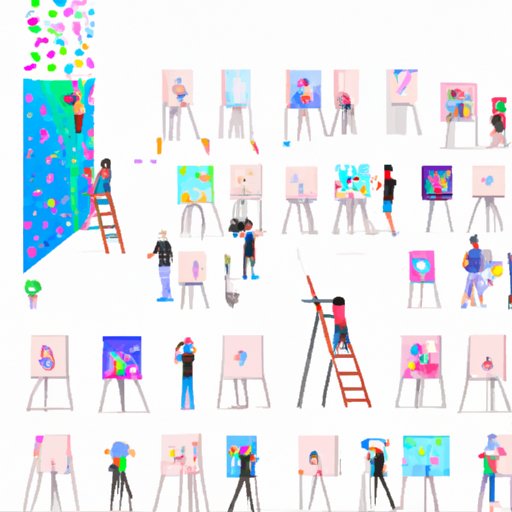
I. Introduction
Despite famous artists like Vincent Van Gogh and Leonardo da Vinci, artists have long struggled to earn a living with their work. The stereotype of the starving artist is familiar to many, and its roots go back several centuries. However, artistic talent continues to be highly valued in today’s society, and many individuals pursue careers in the arts. This article aims to explore the reality of artists’ earning potential and answer the question of how much money do artists make. We’ll address this issue by delving into the average salaries of different types of artists, successful artists’ experiences, compensation in different industries, different revenue streams, and a list of top-earning artists.
II. How much do artists earn on average?
The amount of money artists make varies depending on their industry, experience level, and other factors. For instance, musicians make an average of $72,000 per year, while painters make $55,000 per year. Illustrators earn an average of $47,000 annually, and sculptors earn $47,500.
However, these figures are just a starting point. A musician who has years of experience and has released multiple hit songs, for example, will earn significantly more than an emerging musician just starting out.
III. Successful artists’ experiences
Many successful artists begin their careers by showcasing their talents whenever and wherever possible. They may perform at local open mic nights or galleries, or they may create portfolios and apply for contracts with established corporations. Successful artists’ incomes vary greatly, depending on various factors, including industry, experience, and geographic location.
Factors that can greatly influence an artist’s earning potential may include producing work that’s in high demand, creating social media profiles, building a robust web presence, and networking with other artists and industry professionals.
IV. Compensation in different industries
The amount of money artists make varies depending on the industry in which they work. For instance, a painter who works for a fine art museum may earn a different amount than a musician who works in the live music industry. In the film industry, actors and actresses usually get paid more than those who work behind the scenes, such as cinematographers.
Income also varies by geographic location and can be influenced by social and economic factors. For example, cities with thriving art scenes often pay artists higher wages than rural areas with less demand for art. Artists may also face legal issues that prevent them from earning the full amount for their work, such as intellectual property disputes, licensing restrictions, or piracy.
V. Different revenue streams
There are several revenue streams an artist can explore, including selling art in galleries, offering commissions, getting paid to perform live, licensing music or art to commercial brands, patronage through crowdfunding sites like Patreon or GoFundMe, hosting classes, and providing consultation.
With the advent of the internet and online selling platforms, artists now have many more opportunities to monetize their work. However, artists must be careful when considering the potential revenue streams they pursue, and they should carefully evaluate the cost and time it takes to create quality work and manage the associated paperwork, tax filing, and marketing efforts.
VI. List of top-earning artists
Here are the top-earning artists for the year:
- Jeff Koons – $65 million
- David Hockney – $38.1 million
- Zeng Fanzhi – $37.8 million
- Christophe Pateau – $32.4 million
- Kerry James Marshall – $29.9 million
These artists earn through various sources such as auctions, promotions, and sales of their creations. Some of them have been established names in the art industry, making them highly sought after, while others have continued to produce one-of-a-kind pieces that resonate with buyers.
VII. Realities of earning a living as an artist
While it’s certainly possible to earn a living as an artist, doing so is notoriously difficult. Artists often go through periods of financial instability and may feel pressure to compromise their creative visions to make a sale. Many artists take on side jobs to supplement their earnings and support themselves while they work on their craft.
To succeed as an artist, it’s important to have realistic expectations about the industry. Artists who are passionate about their work and are resourceful can make a living doing what they love. They must be willing to take steps outside of their comfort zones, and continuously seek new opportunities to gain exposure and expand their network.
VIII. Conclusion
So, how much money do artists make? The answer is complex and varies widely depending on several factors. We explored the reality of artists’ earning potential to give readers a better understanding of the work and sacrifices required to build a successful career in the arts. We encourage readers to pursue their passion while keeping in mind that artistic careers often come with financial challenges. We hope that this article has been helpful and informative, and we recommend that readers continue to search for additional guidance and education on making a living as an artist.





